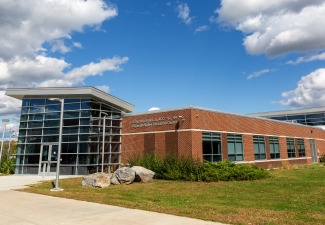SUNY Plattsburgh Wildlife Club Research project: From Bird Counting to a BioBlitz
A nutty aroma enveloped one particular table in the Angell College Center lobby Feb 14.
There on the table, among scattered seeds and loose string, sat a grocery bag filled with pine cones, a bucket with more seeds and — the culprit of the distinctive smell — peanut butter.
These were not a trendy new Valentine’s Day treat but the makings of a research project — one of many conducted by SUNY Plattsburgh’s new Wildlife Club.
Citizen Scientists
The Wildlife Club began its first spring semester project by tabling in the College Center to encourage passersby to make bird feeders for the Great Backyard Bird Count, an annual four-day event that gives bird watchers an opportunity to enter their sightings into a global database.
Those who made feeders could hang them outside, observe them for 15 minutes and then record the species of birds they found on the Great Backyard Bird Count website.
Rory Carroll, president of the Wildlife Club, said scientists would then use the data for bird migration and distribution research.
Community Connection
Dr. Danielle Garneau, faculty liaison for the Wildlife Club and assistant professor of earth and environmental science, said the club hoped for community members to partake in the research as well.
“Our students really wanted to participate and engage the community — not only the campus, but the faculty and townspeople who might be coming through the College Center,” Garneau said. “They’d be participating on a local scale, but they’d be contributing to something that’s much greater.”
Wildlife club member Jimmy Burdick agreed.
“The bird count was a great way to get people involved in a little bit of research,” Burdick said. “It's not difficult to hang up a bird feeder, and it's something a lot of people enjoy.”
Sit Back, Relax and Count Birds
According to Carroll, students and community members made about 50 to 60 feeders as a result of the tabling efforts.
Club members put up feeders near off-campus housing, a home in Peru, N.Y., two locations near the interpretive trail in Rugar Woods, outside the College Center and by several residence halls on campus.
Observers recorded cardinals, dark-eyed juncos, black-capped chickadees, blue jays, purple finches, house finches, mourning doves and a white-breasted nuthatch at the feeders.
“Nothing out of the ordinary, necessarily,” Carroll said. “But still we contributed some good data for an important national project.”
Club members also received some entertainment from the process.
“I was hoping for a bald eagle, but that didn't happen,” Burdick said. “I just got a squirrel that was too happy to run off with my feeder.”
Gearing Up for BioBlitz
Now that the bird count is over, the Wildlife Club is working on two projects: an effort to help the kestrel — a species of bird that has been classified as vulnerable — and a BioBlitz through which members will record as many species as possible in Rugar Woods over the course of 24 hours.
The club has created six kestrel boxes and set them up in various places, including Rugar Woods, Point Au Roche State Park and Lake Alice Wildlife Management Area in Chazy, N.Y., in collaboration with the state Department of Environmental Conservation.
“We will be monitoring the boxes to see if kestrels use them and if they successfully fledge young at those sites,” Carroll said.
Meanwhile, during Earth Week, the public is invited to join the Rugar Woods BioBlitz, Sunday, April 28. In addition to the Wildlife Club and community members, several other student groups and members of the Department of Anthropology, the Department of Biology and the Center for Earth and Environmental Sciences will be on hand to help record species, according to Carroll.
“Ultimately it is our goal to make this a yearly event,” he said.
News

SUNY Adirondack Students Benefit from New Dual Agreement with SUNY Plattsburgh Queensbury
